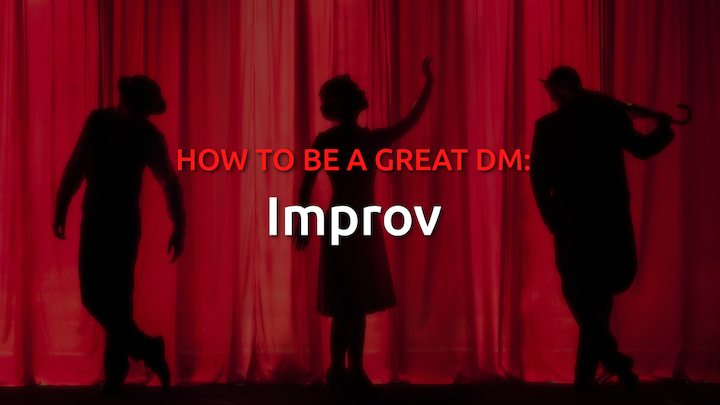Great DMing: when and how to say no
When and how to say no
This is never easy. It can be particularly hard in certain circumstances. But it is crucial to establish boundaries for your game to work properly. Sometimes you need to shoot down a character idea/build because it is too powerful, or it didn’t make any sense. Sometimes you have to let a player fail. Sometimes you have to protect your other PCs from annoying or reckless behavior.
You’re in charge. You’re the leader. You get to say no, when the game needs it.
Here are some scenarios to help you learn when to say no and how to say no without ruining the experience for your players and maintaining a fun, independent storyline of player choices.
When to say no
I had a player who, for reasons we won’t get into, turned into a wild boar. Now that player used kukri knives to fight and didn’t want to give up the bonus he had accumulated. So he asked me if he tied the knives to his tusks could he still get his kukri attack?
The answer? No, that was dumb. No opposable thumbs, no proficiency.
Were there complaints? Oh you betcha there were. Did I back down? Not an inch. Because I knew that winning that battle really mattered in the long run, but the proficiency bonus didn’t.
Why did I say no in this instance? Okay, let’s break it down.
His desire to keep his proficiency was illogical
The other players knew it was illogical
There would be hellish repercussions if I said yes – a) the rules of reality would be bent to allow a player to have his way, which would poison the rest of the rules for the players; b) I would be seen as easily manipulated and not really in charge, which could lead to rampant bad behavior on the parts of my players and cause them to view me and my authority in contempt; c) players would realize that their choices had no bad repercussions (whatever he did to turn into a wild boar), which is contrary to a good game and to life.
If Dungeons and Dragons had no logic, we wouldn’t have such detailed rules. Sometimes that logic is interpretive. Sometimes it’s not.
Players usually know when something is illogical. (Granted, there are players who can argue their logic into being logical. Those times you can choose to say yes to their weird requests.) But even if they whine, they know that their request is preposterous. They are testing you. Don’t give in.
The repercussions of giving into illogical or harmful requests are hellish. You give up the respect of your players. You also rob your players from the opportunity to learn from their choices, both good and bad.
Regardless of what I said above, you can always say yes. You can. You’re in charge. But if you always say yes, you take away something special from the players – the challenge.
Players may whine or complain in the moment, but if they sense that their “win” in the end of the campaign was too easy, they will grow dissatisfied. The thrill of the quest – with the possibility of failure – makes the game worth playing.
Two games later, my player was turned back into a normal(ish) barbarian. He had to push himself to survive as a wild boar in the interim. He learned to play the game as a wild boar and he enjoyed the challenge.
Saying no to his request for proficiency made it clear to everyone that when I put my foot down on something, that was it. You can argue but what the DM says, goes.
How to say no
Just how you go about saying it really depends on you and your group. Mine was a group of guys that knew each other for a long time and constantly gave each other crap. So a flat no was all I needed. But I still gave my explanation, the part about the opposable thumbs. Though they grumbled, they accepted.
No matter how you say no, make it clear. Your game, your rules, but always give your reason. If it’s reasonable, they will usually accept it.
Now, you may have a new group of players or a group that is new to you/each other. In that case, the how of saying no becomes a lot more important. Just like when you say no to someone in real life, saying no in a D&D game can have a lasting impact.
If a new player asks for poisons or a book on how to make poisons and you say, “Of course not, that’s stupid” you may lose a player.
If an experienced player comes up with an elaborate, suicidal plan to save their socks from getting wet while crossing a river and you say, “stop coming up with dumb ideas” you may start a fistfight.
How you say “no” is important. Sometimes it’s a simple word, but sometimes it’s better to:
Ask them, are you sure you want to do that?
Give a quick peek at the possible outcome they may have overlooked
Roll for (insert skill here, such as perception)
The first two are to give them warning about the potential outcome of their action. Like a road sign letting them know a cliff is ahead. This can often be enough to turn back most players from really bad ideas.
However, some will see your warnings and floor it. Speeding at the cliff with all the adrenaline they can muster. For them the third way was created. Let them roll for it. Was it a terrible idea? Sure, but if they fail the roll, then it’s their own fault for a) taking the action and b) failing to roll well. And hey, maybe they roll a 20 and pull off the impossible. Fantastic! Great moments at the table are built on such gambles. Either way it is the player’s action and the player’s consequence. You cannot be blamed, you didn’t roll, just moderated it.
Last thoughts
It’s important to remember when and how to say no at the table. Many crazy things happen at the table but it’s up to you to decide what is and isn’t allowed. Once you know that, it’s your job to find the best way to say no to your players, both experienced and new.
Now get on out there and start denying your players!
Remember, all the organization in the world is helpful. But with a DnD campaign, chaos is likely.
#NumberOneJosiah
Jo is our co-founder, resident DM for Hire and a philosopher of tabletop gaming.
Jessie CM
Jessie is our marketing guru, lover of #NumberOneJosiah and a published author.
Check out some of our Featured blogs!














Kickstarter is a crowded place, so to launch a successful campaign it’s important to know what you will need ahead of time. Specifically, what you're selling, how to make it look fancy, and making certain you know your numbers.